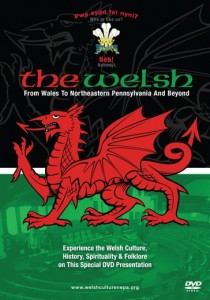About The DVD

 Discover on this DVD…
Discover on this DVD…
- Who are the Welsh, where are we from and what are we all about?
- Why we’re not at all like the English
- Video scenes from Wales and Northeastern Pennsylvania
- Heritage interviews with noted regional Welsh authors, historians, anthracite coal miners and folklorists
- Huge folk gatherings – Christian revival, powerful singing, musical and literary competition
- Our effects on government, industry, spirituality, agriculture and what we overcame
TOTAL RUNNING TIME: 141 minutes
ORDER the DVD
“Pwy Sydd Fel Nyni? Neb!” (WHO IS LIKE US? Nobody!)
Created And Presented To You From:
The Welsh Cultural Endeavor of Northeastern Pennsylvania
Produced and Directed by George C. Horwatt
©2010 George C. Horwatt
DEDICATED TO THE MEMORIES OF CYMRAES (Welsh women).
Margaret Heness Horwatt, Anna Thomas, Mary Heness Ward – Bladge Hill, Edwardsville, Pennsylvania…
…BECAUSE OF THEM I CAN DO THIS
…selected interviews with :
Richard M. Loomis, Ph.D
Wilkes-Barre, Luzerne County
Professor Richard Loomis was born in Denver, Colorado, with Welsh blood emanating from the name Morgan on his mother’s side.
Richard’s formal education began with a BA from John Carroll University, MA & Ph.D from Cornell University (Ph.D 1959, in Medieval & Renaissance Literature).
He was a professor of English at King’s College, Wilkes-Barre, PA, and Nazareth College, Rochester NY. His publications include Dafydd ap Gwilym: The Poems; Edition and translation of The Life of St. Hugh of Avalon: Bishop of Lincoln, 1186-1200, by Gerald of Wales.
He was an invited speaker at a conference honoring St. Hugh held at Lincoln, England and was also the keynote speaker at NAASWCH (North American Association for the Study of Welsh Culture & History) conference held at Rio Grande, Ohio, speaking on Guto’r Glyn a celebrated Welsh poet of the Fifteenth Century.
Professor Loomis also is recognized for these two translations, “Culhwch and Olwen” and “Arthur in Geoffrey of Monmouth” which are included in the new Third Edition of The Romance of Arthur, edited by Norris Lacy and published by Routledge, U. K.
He is a founding member of the St. David’s Society of Rochester and the Genesee Region from 1976 and a member of the St. David’s Society of Wyoming Valley from 1994. Within this decade, he was the author of a novel on Gerald of Wales, titled “The Song of Giraldus,” and he has other works of historical fiction.
With his wealth of knowledge and keen talent, perhaps it is no coincidence that Dick Loomis eventually settled in this bastion of Welsh culture. Currently Dr. Loomis is an active and frequent advisor to The Welsh Cultural Endeavor of Northeastern Pennsylvania where he provides much assistance in dealing in with Welsh projects.
~~~~~~~~~~~~~~~~~~
William A. Hastie
Anthracite Miner / Historian / Lecturer
– West Pittston, Luzerne County
Welshman Bill Hastie had been an anthracite coal miner for many years. He was thrown out of work and would never return as a miner – his last mining job abruptly ending on January 22, 1959 when the Susquehanna River crashed through a thin rock roof of River Slope Mine of the Knox Coal Company. Scheduled to work later that day, his life was spared as 12 men died and 69 others escaped disaster in the Pittston area of Port Griffith, Luzerne County.
Hastie’s life changed forever – with no job for a substantial period, he took a lesser paying job at Standard Equipment Company in Kingston, Luzerne County. Welshmen known as the Powell and Davies Tractor Company founded the firm. The name changed when another Welshman by the name of Ben L. Jenkins secured financing for the heavy mining equipment dealership that sold names like Euclid and Terex.
Jenkins at the time was the prime leader in Welsh events of the Wyoming Valley. He soon recognized that Bill was an extraordinarily self-learned man in many subjects, especially Welsh culture and coal mining. In 1960, Jenkins encouraged Hastie to deliver his first lecture during the Warrior Run Welsh Presbyterian Church Centenary. He continues now 50 years later with dozens of newspapers, radio and television station op-ed pieces and interviews. Most recently, he was a consultant for local author Robert P. Wolensky, who wrote the books, The Knox Mine Disaster and The Voices of the Knox Disaster. With modesty, he prides himself with the fact that uncountable students conferred with him for numerous school projects. He is not only quick with unlimited facts and dates, but articulates his points with picturesque reality and detail
– Welsh lifestyle being his specialty. At age 93, it remains unsurprising to find this amazing man in front of a camera. Or behind a microphone. Or behind the podium of a packed house.
When asked how he became so exceptionally educated, he simply replied, – “I did a tremendous amount of reading and listened closely.”
At a recent Welsh concert held in Wilkes-Barre, this past fall 2018, our long-time friend Bill informed us that he was “rounding the bend to 100”. You go Bill!!
~~~~~~~~~~~~~~~~~~
Anthony T. P. Brooks
Historian / Lecturer
– Wilkes-Barre, Luzerne County
Tony Brooks is a tenth generation native of Pennsylvania descending from Isaac Bennett, an original shareholder in the Susquehanna Company who came to the Wyoming Valley to plant crops in 1762. Isaac’s nephew Thomas Bennett was in the “Forty Fort” during the 1778 Battle and Massacre of Wyoming.
Don’t let the lineage fool you. Tony claims to be a perfect blend of seven different nationalities that make up the Wyoming Valley – from Connecticut Yankee farmers, Irish canal workers, and German butchers to English miners, Welsh Methodists, and Byzantine Catholics. Tony is a true product of the Wyoming Valley.
Since December 2008, Tony has served as the executive director of the Luzerne County Historical Society, the first county historical society in Pennsylvania. He is responsible for the Luzerne County Museum, the Bishop Memorial Library, the Denison House and the Swetland Homestead. The Society has 823 members and he’s always looking for more.
If there is any information on Wyoming Valley history available, Tony can and will find it.
A native of Forty Fort, he is a graduate of Wyoming Valley West and the University of Pennsylvania where he studied history. He lives in downtown Wilkes-Barre.
~~~~~~~~~~~~~~~~~~
Fiona Siobhan Powell
Folklorist / Storyteller / Radio Broadcaster
– Milton, Northumberland County
Fiona Powell spent her childhood wandering around Europe, when she wasn’t ensconced in a “very proper” school in England, learning Latin, History, and how to speak “BBC received”.
Her ancestors hail from Brecon, located just above the famous coal mining valleys, and it was to Wales that she returned in her early teens, promising to the land of her fathers her everlasting fealty.
After attending an Agricultural College, Fiona worked as a shepherd until moving to the USA in 1988, with her four children. Not being able to find any employment in the agriculture sector, Fiona accidentally fell into storytelling and turned her lifelong passion for Celtic folklore into a career. Fiona is a folklorist specializing in the folklore and stories of her people, their history, and the stories of Welsh immigration into Pennsylvania. She has researched the lives of infamous Welshmen, such as Joseph Parry as well as the unsung heroes, coal miners and ironworkers, who lived their lives in obscurity.
Fiona is a rostered artist with the Pennsylvania Council of the Arts, specializing in early childhood education, taking stories to schools and Headstart organizations.
Fiona also works for WVIA Radio, as a producer and on–air host. Not able to stay away from her native Wales for very long, she continues her studies in folklore and history in old Cymru.
As she captivates spellbound audiences with endless Welsh folklore, time seems irrelevant. At the conclusion of the program, it is difficult to come away from a gathering with Fiona without a lump in your throat or a dry eye – even if you’re not Welsh.
~~~~~~~~~~~~~~~~~~
…also breathtaking scenery taken from Northeastern Pennsylvania and Wales and a with Welsh narrator…
~~~~~~~~~~~~~~~~~~~~~
THE WELSH by Wynn Griffith
The Pattern of Life
The Oxford Dictionary defines a nation as ‘ A distinct race of people, characterized by common descent, language or history, usually organized as a separate political state and occupying a define territory.’
Until Act of Union in 1536, Wales fulfilled these requirements. Since then, it has, like England, ceased to be ‘organized as a separate political state’. But no one would suggest that political union with England had in any way deprived Wales of its remaining rights to recognition as a nation, or that government from London had turned a Welshman into an Englishman, except for the purposes of a common system of law. However, it is as difficult for a Welshman to argue his title to his nationality as it is for an Englishman to subordinate his own claims, and for the same reason: they both take it for granted, and they can only invite any doubter to ‘come and see for himself’.
Sir Alfred Zimmerman, whose residence in Wales qualified him to speak with knowledge of its people, and whose wide experience of other peoples protected him from hasty generalizations, says that, ‘Welshmen are the inheritors of a civilization which is both very ancient and very distinctive. How ancient I will not presume to say, but Wales and the Welshmen of Giraldus Cambrensis are at least as true to the modern type as the England and the Englishmen of Chaucer… How truly distinctive Welsh civilization is becomes clear to anyone who will reflect on the significance of the survival of the Welsh language. Welsh has survived because it represents something – a spirit, a culture, a national character, an atmosphere – which, unlike its compeers in Scotland and Ireland, in Cornwall and the Isle of Man, cannot survive the transformation into English.
~~~~~~~~~~~~~~~
The Pattern of Life Continues
Struggling for identity everywhere they went, the Welsh undoubtedly made their impact in the new world. Penn’s Woods was no exception. William Penn, a Welshman with Tudor lineage, declared his land charter ‘New Wales’ – a refuge for persecuted Quakers that eventually became the Commonwealth of Pennsylvania.
For Northeastern Pennsylvania, the 1750s brought land grants for thousands of English settlers known as ‘Connecticut Yankees’. As famine, disease, economic decline, and religious persecution escalated in Europe, a second wave of immigrants appeared decades later in this area of the Commonwealth. They were Welsh or, as they were known, Cymry (Khumry or Kimmeroi as identified by the ancient Assyrian Emperors). Attracted to the rich soil and the region’s natural resources of coal, iron, and timber, their presence became integral to the area.
Despite the Act of Union of 1536 two centuries earlier, this distinct ethnicity never assimilated with England.
The propagation of Welsh lifestyle not only negates the torrid ancestral act, but also exemplifies the stark dissimilarities that inhabit the Northeastern Pennsylvania region centuries later within the realm of poetry, prose, music, Christian lifestyle, industrialization, and governance. No doubt, we mirrored Wales for over three centuries and more than anywhere in the U. S.
Learn why many area descendants throughout the generations of old Cymru still return home and hunger for origin.
Leave a Reply
You must be logged in to post a comment.

